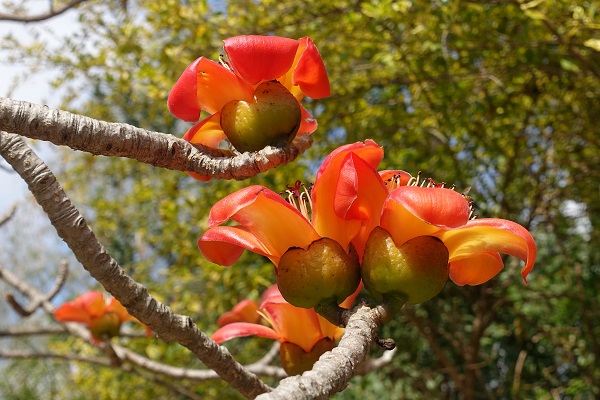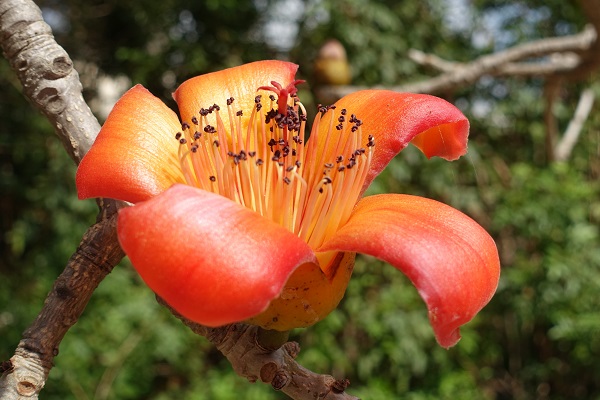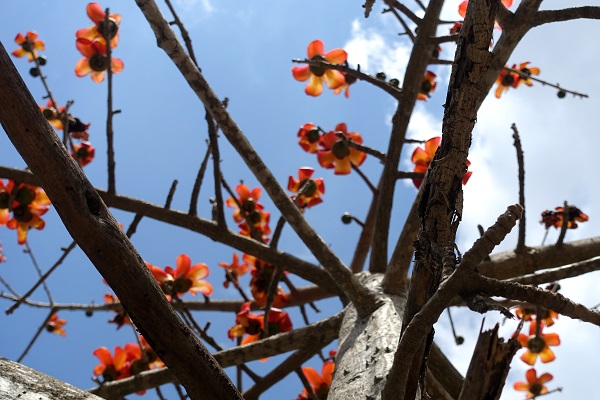Red Silk Cotton Tree, Kapok Tree,
Hebrew: בומבק הודי ,בומבק צייבה, Arabic: خيزران
| Scientific name: | Bombax ceiba L. | |
| Synonym name: | Bombax malabaricum DC. Gossampinus malabarica (DC.) Merr. Salmalia malabarica (DC.) Schott & Endl. | |
| Common name: | Red Silk Cotton Tree, Kapok Tree | |
| Hebrew name: | בומבק הודי ,בומבק צייבה | |
| Arabic name: | خيزران | |
| Family: | Malvaceae, Subfamily: Bombacoideae, בומבקסים |

|
| Life form: | Deciduous large tree up to 20-25 m tall and spreads 8-15 m wide. | |
| Stems: | Woody, solid, erect, columnar trunk, grey, glabrous bark with hard conical black prickles, delicate branches cylindrical, glabrous, smooth with distinct nodes and internodes. | |
| Leaves: | palmate with about 6 leaflets radiating from a central point, an average of 7~10 centimeters wide, 13~15 centimeters in length. The leaf's long flexible petiole is up to 20 cm long. | |
| Inflorescence: | Solitary or cluster of several extra-axillary flowers. At the time of flowering, the tree becomes almost leafless. | |
| Flowers: | Cup-shaped flowers solitary or clustered, axillary or sub-terminal, fascicles at or near the ends of the branches, when the tree is bare of leaves, an average of 7~11 centimeters wide, 14 centimeters in width, petels up to 12 centimeters in length, calyx is cup-shaped usually 3 lobed, an average of 3~5 centimeters in diameter. Staminal tube is short, more than 60 in 5 bundles. stigma is light red, up to nine centimeters in length, ovary is pink, 1.5~2 centimeters in length, with the skin of the ovary covered in white silky hair at 1mm long. | |
| Fruits / pods: | Brown oval capsule, which, when ripe, contains white fibres like cotton | |
| Flowering Period: | February, March | |
| Habitat: | Prefers dry or moist soil | |
| Distribution: | Park | |
| Chorotype: | South Asian |

Derivation of the botanical name: Bombax from the Greek bombyx, referring to things of silk or cotton, and alludes to the abundant, silk-like or cottony fibers in the fruits. ceiba, a Spanish derivative of a Taino or other Arawakan (South American indigenous languages) name used for a group of large, tropical trees related to Bombax, many of which produce kapok or silk-cotton in their fruits. malabaricum, from the Malabar coast of India. Gossampinus, a variant of gossympinus, a Latin name used by Plinius for the cotton tree. Salmalia, origin: Salmali, a Sanskrit name for Salmalia Malabarica.

|